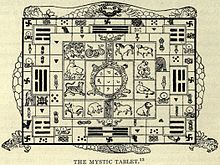- Lo Shu Square
-
Lo Shu Square (simplified Chinese: 洛书; traditional Chinese: 洛書; pinyin: luò shū; also written 雒書; literally: Luo (River) Book/Scroll) or the Nine Halls Diagram (simplified Chinese: 九宫图; traditional Chinese: 九宮圖; pinyin: jiǔ gōng tú), is the unique normal magic square of order three. Lo Shu is part of the legacy of the most ancient Chinese mathematical and divinatory (Yi Jing 易經) traditions, and is an important emblem in Feng Shui (風水), the art of geomancy concerned with the placement of objects in relation to the flow of qi (氣) 'natural energy'.
Chinese legends concerning the pre-historic Emperor Yu (夏禹) tell of the Lo Shu, often in connection with the Ho Tu (河圖) figure and 8 trigrams. In ancient China there was a huge deluge: the people offered sacrifices to the god of one of the flooding rivers, the Lo river (洛水), to try to calm his anger. A magical turtle emerged from the water with the curious and decidedly unnatural (for a turtle shell) Lo Shu pattern on its shell: circular dots giving unitary (base 1) representations (figurate numbers) of the integers one through nine are arranged in a three-by-three grid.
 The Lo Shu square on the back of a small turtle (in the center), surrounded by the signs of the Chinese Zodiac and the Eight trigrams, all carried by a large turtle (which, presumably, stands for the Dragon horse that had earlier revealed the trigrams to Fu Xi). A Tibetan design.
The Lo Shu square on the back of a small turtle (in the center), surrounded by the signs of the Chinese Zodiac and the Eight trigrams, all carried by a large turtle (which, presumably, stands for the Dragon horse that had earlier revealed the trigrams to Fu Xi). A Tibetan design.
The odd and even numbers alternate in the periphery of the Lo Shu pattern; the 4 even numbers are at the four corners, and the 5 odd numbers (outnumbering the even numbers by one) form a cross in the center of the square. The sums in each of the 3 rows, in each of the 3 columns, and in both diagonals, are all 15 (fifteen is the number of days in each of the 24 cycles of the Chinese solar year). Since 5 is in the center cell, the sum of any two other cells that are directly through the 5 from each other is 10 (e.g., opposite corners add up to 10, the number of the Ho Tu (河圖)).
The Lo Shu is sometimes connected numerologically with the Ba Gua 八卦 "8 trigrams", which can be arranged in the 8 outer cells, reminiscent of circular trigram diagrams. Because north is placed at the bottom of maps in China, the 3x3 magic square having number 1 at the bottom and 9 at the top is used in preference to the other rotations/reflections. As seen in the "Later Heaven" arrangement, 1 and 9 correspond with ☵ Kǎn 水 "Water" and ☲ Lí 火 "Fire" respectively. In the "Early Heaven" arrangement, they would correspond with ☷ Kūn 地 "Earth" and ☰ Qián 天 "Heaven" respectively. Like the Ho Tu (河圖), the Lo Shu square, in conjunction with the 8 trigrams, is sometimes used as a mandalic representation important in Feng Shui (風水) geomancy.
Further Readings
- Frank J. Swetz, The Legacy of the Luoshu, A K Peters/CRC Press; 2Rev Ed edition (16 Jun 2008), ISBN 978-1568814278.
External links
Categories:- Magic squares
Wikimedia Foundation. 2010.


